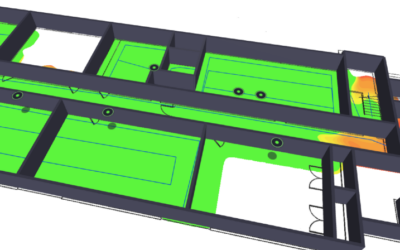Introduction
Conducting Wi-Fi site surveys is important to ensure the best network performance. However, many misconceptions exist, which can lead to poor practices and misunderstandings about what makes a successful survey. In this blog, we will debunk some of the most common myths and provide a better understanding of effective survey strategies.
Myth 1: “More Data Points Always Improve Accuracy”
A common misconception about Wi-Fi site surveys is that simply collecting more data points automatically leads to better survey results. While it might seem logical that more data equals better insights, the reality is that both the quality and strategic collection of the data points are crucial. More data is indeed beneficial, but only if collected at the right locations and in the right manner. In addition, capturing styles will vary based on the data desired.
During a site survey, professionals use mobile devices to mark their locations, while specialized tools, like Sidos Wave, actually collect the survey data. Accurately marking your location and ensuring consistent data collection methodology is essential. Walking at a constant speed and marking your location accurately at key points provide a much clearer picture of the network environment. Therefore, it’s vital to focus on collecting a sufficient quantity of high-quality data points.
Inconsistent location marking leads to errors later in the process of analyzing the heatmaps, and while frequent marking can reduce these errors, maintaining accuracy is paramount. Ensuring data points are closer together can improve accuracy, especially in areas where precision is critical, such as around potential interference sources or structures that attenuate the signal significantly. Consistent, accurate location marking, combined with strategic data collection, ensures that the data truly reflects the network’s performance.
Fact: More data points can improve accuracy during a site survey only when they are collected strategically, accurately, and in the right locations using a professional survey tool.
Myth 2: “You Can Skip Site Surveys”
Another misconception is that site surveys are optional, especially if you have predictive designs or rely on controller data. While predictive designs are useful for initial planning, they cannot capture the real-world characteristics of a site. Physical obstructions and the actual layout of the environment can significantly impact network performance in ways that predictive models cannot simulate.
Site surveys are indispensable because they provide a comprehensive view of the actual conditions in the environment where the network operates. During a site survey, you can identify and document physical obstructions such as walls, furniture, and other structures that could interfere with signal propagation.
Data from the Wi-Fi controller, while valuable, offers a limited perspective as it reflects what the access points can see. This data might not accurately depict the user experience, leading to potential blind spots in network performance. Skipping site surveys can result in missed issues that only become apparent after deployment, leading to costly and time-consuming troubleshooting.
By conducting thorough site surveys, you ensure that your network design is based on real-world data, which leads to more reliable and efficient network performance. Site surveys allow you to fine-tune your network design, optimize access point placement, and ensure that coverage and capacity meet the actual needs of the environment.
Fact: Site surveys are essential for capturing the real-world characteristics of a network environment, ensuring accurate and reliable network performance beyond what predictive designs and controller data can offer.
Myth 3: “You Don’t Need Recurring Surveys”
Wi-Fi networks operate in dynamic environments. The performance and coverage of a network can change over time due to various factors such as new construction, changes in office layout, the addition of new devices and users, and even changes in neighboring networks. Believing that a single site survey is sufficient for the lifetime of a network is a dangerous myth.
Recurring surveys are essential to maintain optimal performance. Regular assessments allow you to identify and address new sources of interference and other factors that can degrade network quality. For instance, new walls or partitions can alter signal propagation.
One of the most significant external factors is the presence of other Wi-Fi networks nearby. Neighboring networks can change their channel usage, power levels, or even their physical locations, which can impact your network’s performance. Regular site surveys help detect these changes and allow for adjustments to minimize interference and optimize performance.
Conducting periodic site surveys enables proactive network management. By regularly evaluating the network’s performance, you can detect potential issues early and make necessary adjustments before they become significant problems. This proactive approach helps maintain a high level of service and reduces the likelihood of user complaints and downtime.
Fact: Recurring site surveys are crucial for adapting to changes in the environment, including the impact of neighboring networks, and for maintaining optimal network performance over time.
Myth 4: “One Survey Walk Pass is Enough”
The idea that a single pass through an area during a site survey is sufficient to gather all necessary data is another myth that can lead to incomplete and inaccurate results. The necessity of multiple passes depends on the tools and context of the survey. For example, if you are carrying a survey device against your body, the body’s attenuation can affect the signal readings, requiring you to walk back and forth to mitigate the problem..
Walking through an area just once might not provide a complete picture, especially if you have obstacles like columns or partitions. You may need to walk around these obstacles from multiple angles to capture accurate data. This approach ensures that you are not missing any potential dead spots or areas of weak coverage.
Additionally, walking in both directions and covering all potential paths may help mitigate the signal shadowing caused by body attenuation. It is highly recommended to do a perimeter walk of each room, with multiple passes in larger rooms and around major obstacles. When doing continuous surveys, be sure to add multiple location markers based on fixed features that are not easily moved, such as windows, columns, and staircases. Interior doors can be moved during remodeling and are, therefore, less reliable for a fixed position than previously mentioned features.
Ensuring that survey data is collected under various conditions allows for a more robust and resilient network design. By understanding how the network performs under different scenarios, you can make more informed decisions about access point placement, channel allocation, and other critical factors.
Fact: One survey walk pass is often not enough; multiple passes and varied paths are necessary to capture a comprehensive and accurate picture of network performance.
Conclusion
Remember these points about Wi-Fi site surveys: It’s important to understand that both the quality and quantity of measurement data are crucial. Site surveys are necessary, and regular assessments are important. Thoroughness often requires multiple passes. Keeping these points in mind can significantly improve the effectiveness of your network planning and optimization efforts.
Regularly conducted, high-quality surveys are essential for maintaining optimal network performance and adapting to changes in the environment. By moving beyond these common misconceptions, network professionals can ensure that their Wi-Fi networks are robust, reliable, and ready to meet the evolving demands of users.




